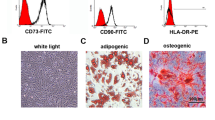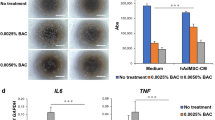Abstract
Bone marrow mesenchymal stem cell (BMSC)–derived exosomes (BMSC-Exos) have a variety of biological functions and are extensively involved in the regulation of inflammatory diseases, as well as tissue repair and regeneration. However, the mechanism of action of these compounds in dry eye disease (DED) in mice is still unclear. This study demonstrated that the Treg/Th17 ratio was strongly imbalanced in DED clinical samples. BMSC-Exos can modulate the Treg/Th17 balance, improve the integrity of the corneal epithelial layer, and ameliorate DED progression in mice. Mechanistically, BMSC-Exos dramatically decreased the levels of IL-17 and IL-22; increased the levels of IL-4, IL-10, and TGF-β1; and increased tear secretion and the number of goblet cells in the conjunctiva in mice, thus alleviating the progression of DED. This effect is achieved by BMSC-Exos through the delivery of miR-21-5p to target and restrain TLR4, thereby restraining the MyD88/NF-κB pathway. Our study showed that the upregulation of miR-21-5p in BMSC-Exos may be a therapeutic target for DED. These findings support new ideas and a basis for treating DED, as well as for further study of the application value of exosomes in alleviating DED.






Similar content being viewed by others
Data availability
The datasets that were used and/or analyzed during the current study are available from the corresponding author upon reasonable request.
References
Alunno A, Carubbi F, Bistoni O et al (2015a) T regulatory and T helper 17 cells in primary Sjögren’s syndrome: facts and perspectives. Mediators Inflamm 2015:243723
Alunno A, Montanucci P, Bistoni O et al (2015b) In vitro immunomodulatory effects of microencapsulated umbilical cord Wharton jelly-derived mesenchymal stem cells in primary Sjögren’s syndrome. Rheumatology (oxford) 54:163–168
Baker RG, Hayden MS, Ghosh S (2011) NF-κB, inflammation, and metabolic disease. Cell Metab 13:11–22
Buckley RJ (2018) Assessment and management of dry eye disease. Eye (lond) 32:200–203
Chihaby N, Orliaguet M, Le Pottier L et al (2021) Treatment mesenchymal stem cells a systematic review. Int J Mol Sci 22:10474
Kang Y, Song Y, Luo Y et al (2022) Exosomes derived from human umbilical cord mesenchymal stem cells ameliorate experimental non-alcoholic steatohepatitis via Nrf2/NQO-1 pathway. Free Radical Biol Med 192:25–36
Kawasaki T, Kawai T (2014) Toll-like receptor signaling pathways. Front Immunol 5:461
Kim H, Lee MJ, Bae EH et al (2020) Comprehensive molecular profiles of functionally effective MSC-derived extracellular vesicles in immunomodulation. Molecular Therapy 28:1628–1644
Lawrence T (2009) The nuclear factor NF-kappaB pathway in inflammation. Cold Spring Harb Perspect Biol 1:a001651
Lee HS, Hattori T, Park EY et al (2012) Expression of toll-like receptor 4 contributes to corneal inflammation in experimental dry eye disease. Invest Ophthalmol vis Sci 53:5632–5640
Li B, Xing Y, Gan Y et al (2021) Labial gland-derived mesenchymal stem cells and their exosomes ameliorate murine Sjögren’s syndrome by modulating the balance of Treg and Th17 cells. Stem Cell Res Ther 12:478
Liu Z, Xie H, Li L et al (2023) Single-cell landscape reveals the epithelial cell-centric pro-inflammatory immune microenvironment in dry eye development. Mucosal Immunol 24:S1933-0219(23)00091–0
Ma B, Athari SS, Mehrabi Nasab E et al (2021) PI3K/AKT/mTOR and TLR4/MyD88/NF-κB signaling inhibitors attenuate pathological mechanisms of allergic asthma. Inflammation 44:1895–1907
Messmer EM (2015) The pathophysiology, diagnosis, and treatment of dry eye disease. Deutsches Arzteblatt Int 112:71–81 (quiz 82)
Papas EB (2021) The global prevalence of dry eye disease: a Bayesian view. Ophthal Physiol Optics 41:1254–1266
Peri F, Piazza M (2012) Therapeutic targeting of innate immunity with Toll-like receptor 4 (TLR4) antagonists. Biotechnol Adv 30:251–260
Portal C, Gouyer V, Gottrand F et al (2019) Ocular mucins in dry eye disease. Exp Eye Res 186:107724
Reins RY, Lema C, Courson J et al (2018) MyD88 deficiency protects against dry eye-induced damage. Invest Ophthalmol vis Sci 59:2967–2976
Rouen PA, White ML (2018) Dry eye disease: prevalence, assessment, and management. Home Healthcare Now 36:74–83
Rui K, Hong Y, Zhu Q et al (2021) Olfactory ecto-mesenchymal stem cell-derived exosomes ameliorate murine Sjögren’s syndrome by modulating the function of myeloid-derived suppressor cells. Cell Mol Immunol 18:440–451
Şimşek C, Doğru M, Kojima T et al (2018) Current management and treatment of dry eye disease. Turkish J Ophthalmol 48:309–313
Sotozono C, Ueta M, Yokoi N (2018) Severe dry eye with combined mechanisms is involved in the ocular sequelae of SJS/TEN at the chronic stage. Invest Ophthalmol Vis Sci 59:Des0-des86
Tong L, Hao H, Zhang Z et al (2021) Milk-derived extracellular vesicles alleviate ulcerative colitis by regulating the gut immunity and reshaping the gut microbiota. Theranostics 11:8570–8586
Vasudevan S, Tong Y, Steitz JA (2007) Switching from repression to activation: microRNAs can up-regulate translation. Science (New York, N.Y.) 318:1931–1934
Vehof J, Utheim TP, Bootsma H et al (2020) Advances, limitations and future perspectives in the diagnosis and management of dry eye in Sjögren’s syndrome. Clin Exp Rheumatol 38(Suppl 126):301–309
Wang G, Li H, Long H et al (2022) Exosomes derived from mouse adipose-derived mesenchymal stem cells alleviate benzalkonium chloride-induced mouse dry eye model via inhibiting NLRP3 inflammasome. Ophthalmic Res 65:40–51
Wei CB, Tao K, Jiang R et al (2017) Quercetin protects mouse liver against triptolide-induced hepatic injury by restoring Th17/Treg balance through Tim-3 and TLR4-MyD88-NF-κB pathway. Int Immunopharmacol 53:73–82
Woo SR, Corrales L, Gajewski TF (2015) Innate immune recognition of cancer. Annu Rev Immunol 33:445–474
Xie Y, Deng Q, Guo M et al (2023) Proanthocyanidins: a novel approach to Henoch-Schonlein purpura through balancing immunity and arresting oxidative stress via TLR4/MyD88/NF-κB signaling pathway (Review). Exp Ther Med 25:300
Xing Y, Li B, He J et al (2022) Labial gland mesenchymal stem cell derived exosomes-mediated miRNA-125b attenuates experimental Sjogren’s syndrome by targeting PRDM1 and suppressing plasma cells. Front Immunol 13:871096
Yang N, Liu X, Chen X et al (2022) Stem cells from exfoliated deciduous teeth transplantation ameliorates Sjögren’s syndrome by secreting soluble PD-L1. J Leukoc Biol 111:1043–1055
Yasuda K, Takeuchi Y, Hirota K (2019) The pathogenicity of Th17 cells in autoimmune diseases. Seminars in Immunopathology 41:283–297
Zhang L, Yu D (2019) Exosomes in cancer development, metastasis, and immunity. Biochimica et biophysica acta. Reviews on Cancer 1871:455–468
Zimmer N, Trzeciak ER, Graefen B et al (2022) GARP as a therapeutic target for the modulation of regulatory T cells in cancer and autoimmunity. Front Immunol 13:928450
Funding
This study was supported by the Yunnan Basic Research Program (202301AY070001-156), the National Natural Science and Technology Foundation project (82360201), the Health Research Project of Kunming Health Commission (2020–07-02–112), the Yunnan Province Young and Middle-Aged Academic and Technical Leaders Reserve Talent Project (02405AC350103), the Kunming Health Science and Technology Personnel Training Project, and the “ten hundred thousand” project (2020-SW [province]-01).
Author information
Authors and Affiliations
Contributions
All of the authors contributed substantially to this manuscript. Conceptualization, Dandan Zhao and Hao Ji; methodology, Dandan Zhao; software, Hongxia Zhao and Yanze Xu; validation, Anni He; formal analysis, Dandan Zhao; investigation, Dandan Zhao, Hao Ji, and Yang He; resources, Yang He; writing—original draft preparation, Dandan Zhao and Hao Ji; writing—review and editing, Yang He; visualization, Hongxia Zhao, Yanze Xu, and Anni He; supervision, Yang He; funding acquisition, Yang He. All of the authors have read and agreed to the published version of the manuscript.
Corresponding author
Ethics declarations
Ethics approval and consent to participate
Informed consent was obtained from all of the patients. The experiments were approved by the Medical Ethics Committee of Kunming Yan’an Hospital (approval number: 2022–056-01), and all of the methods/studies were conducted in accordance with the Declaration of Helsinki. All of the animal experiments were approved by the Animal Ethics and Welfare Committee of Kunming Yan’an Hospital (approval number: 2022051).
Competing interests
The authors declare no competing interests.
Rights and permissions
Springer Nature or its licensor (e.g. a society or other partner) holds exclusive rights to this article under a publishing agreement with the author(s) or other rightsholder(s); author self-archiving of the accepted manuscript version of this article is solely governed by the terms of such publishing agreement and applicable law.
About this article
Cite this article
Zhao, D., Ji, H., Zhao, H. et al. BMSC-derived exosomes regulate the Treg/Th17 balance through the miR-21-5p/TLR4/MyD88/NF-κB pathway to alleviate dry eye symptoms in mice. In Vitro Cell.Dev.Biol.-Animal (2024). https://doi.org/10.1007/s11626-024-00910-6
Received:
Accepted:
Published:
DOI: https://doi.org/10.1007/s11626-024-00910-6




